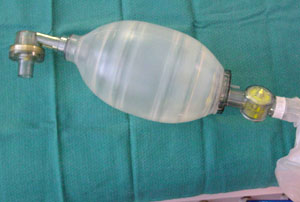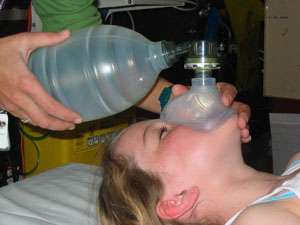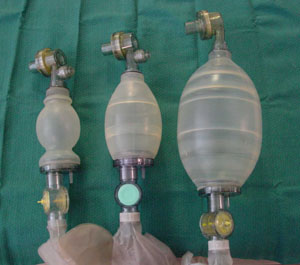| Admissions | Accreditation | Booksellers | Catalog | Colleges | Contact Us | Continents/States/Districts | Contracts | Distance Education | Emergency | Examinations | Forms | Grants | Hostels | Honorary Doctorate degree | Investment | Instructors | Lecture | Librarians | Membership | Professional Examinations | Programs | Progress Report | Recommendations | Research Grants | Researchers | Students login | School | Search | Seminar | Study Center/Centre | Sponsorship | Tutoring | Thesis | Universities | Work counseling |
|
Breathing * If support required, use bag and mask ventilation prior to tracheal intubation * If breathing adequate, provide oxygen 15 litres per minute via Hudson mask. * Ensure adequate monitoring - saturation, respiratory rate, pulse, ECG, Blood Pressure. * Continually reassess and monitor trends.  Self-inflating bag Bag and Mask Ventilation If the airway is stable with or without an oropharngeal airway, and the patient requires breathing support, bag and mask ventilation, with a self-inflating bag, can be used. Reassess whilst using bag and mask ventilation. If there is any further inadequacy, consider intubation. See below  * Choose suitable size mask (chapter 2 Practical Procedures, Bag & Mask Ventilation) * Choose suitable size bag * 3 sizes available -250mls -500mls -1500mls  Sizes of bags * Attach mask to bag. * Attach to wall oxygen 15 litres/min. * Provide insuflations sufficient to inflate chest. * Ascultate the chest and ensure equal bilateral air entry and chest movement on insuflations. * Allow passive expiration 3 times longer than inspiration breath. * Rate of 20/minute. The masks come in many sizes, including newborn, infant, child, and adult (small, medium, and large). Choosing the appropriate size helps to create a good seal and, therefore, aids effective ventilation. Bags for BVM ventilation also come in different types. Newer bags are equipped with a pressure valve. Some bags have one-way expiratory valves to prevent the entry of room air; these allow for delivery of greater than 90% oxygen to ventilated and spontaneously breathing patients. Bags lacking this feature deliver a high concentration of oxygen during positive pressure ventilation but only deliver 30% oxygen during spontaneous breaths. |
